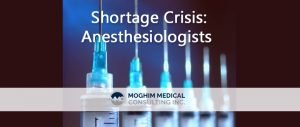 Much of the public and, of course, the medical community are aware that the physician shortage is worsening, but within the ongoing shortage is a brewing crisis that even many medical professionals and administrators may not recognize. This crisis centers on the dwindling number of anesthesia providers that has been exacerbated by many internal industry factors like high retirement numbers as well as external circumstances including a rapidly aging population and the recent travel ban.
Much of the public and, of course, the medical community are aware that the physician shortage is worsening, but within the ongoing shortage is a brewing crisis that even many medical professionals and administrators may not recognize. This crisis centers on the dwindling number of anesthesia providers that has been exacerbated by many internal industry factors like high retirement numbers as well as external circumstances including a rapidly aging population and the recent travel ban.
Many providers are aware of the chronic shortage of anesthesia providers. There are currently about 30,000 anesthesiologists practicing in the United States, down from 35,000 in 2011. There was an estimated shortage of 3,800 anesthesiologists in 2011, and trends suggest that this shortage will only grow in the coming years. By 2020, the shortage of anesthesiologists is expected to grow to 12,500, although there is projected to be a surplus of about 8,000 Certified Registered Nurse Anesthetists (CRNA).
Impact on the Quality of Care
The lack of physician anesthesia providers is likely to have a dramatic impact on the quality of health care in this country. Without qualified anesthesiologists, many critical surgical procedures may be delayed or even performed under the supervision of CRNAs, rather than medical doctors. These bottlenecks in delivery could compromise the caliber of care that many patients receive.
The demand for anesthesiologists will only grow in the coming years as the U.S. population ages and more people obtain health coverage. The number of Americans aged 65 or older is expected to increase to 83.7 million by 2050, almost twice the number in 2012. This rapidly growing demographic should place additional strains on an already overburdened health care system that relies heavily on anesthesia providers.
Contributing Factors
The anesthesia specialty is unique in a number of regards that is contributing to the ongoing shortage. More anesthesiologists aged 50 or older are likely to enter full retirement than other physician specialists. This is related to comparatively lower job satisfaction than their medical colleagues stemming from poor compensation and excessive on-call responsibilities.
The dual pressures of onerous professional responsibilities and inadequate compensation are not likely to diminish in the near future. While the insured population continues to grow, major payers like Medicare continue to undercut private insurance reimbursement rates. On average, Medicare only pays 30 percent of what private payors provide.
The travel ban signed by President Donald Trump has also added to the strain on the profession. Many of the physicians and anesthesia providers that could help alleviate the shortage hail from countries included in the ban. Although the ban is not in effect at the moment—awaiting review by the U.S. Supreme Court—its intent has had a negative effect on prospective medical professionals.
To compound this shortage of providers is a widespread shortage of anesthetic drugs. According to a 2012 ASA survey, almost 90 percent of physicians reported a shortage of at least one anesthetic medication at some point during the year. Renewed collaboration with manufacturers is required to maintain an adequate supply of these essential compounds.
Article written by:
Dr. Robert Moghim, CEO Moghim Medical Consulting Inc.
